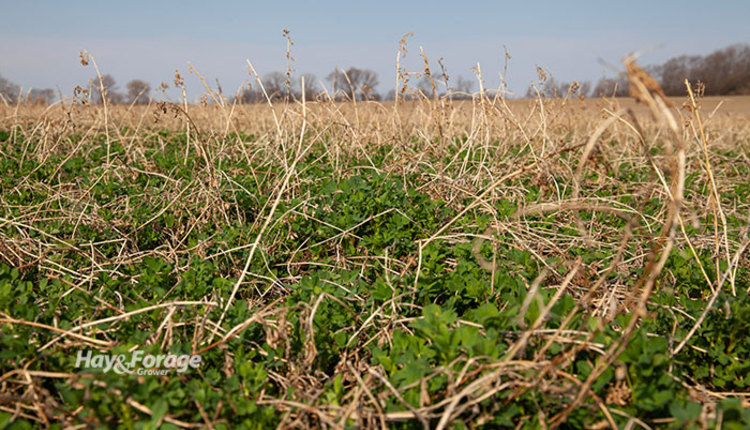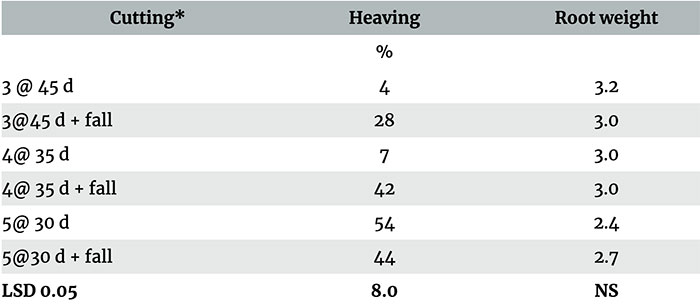
In areas where temperatures are hovering around the freezing point, alfalfa heaving may become a prominent issue. This uprooting of plants as a result of repeated freezing and thawing cycles may be an even bigger risk if forage was cut too short last fall.
The two main forms of heaving are primary heaving and secondary heaving. The former occurs during short durations of freezing and thawing when the expansion of frozen water lifts plant crowns above the ground. The latter is caused by deeper frost penetration when laminar ice forms parallel to the soil surface and forces forage upward.
Craig Sheaffer, extension forage agronomist, and Nathan Drewitz and Troy Salzer, extension educators with the University of Minnesota, say damage from secondary heaving is more intense and has the potential to uproot large taproots of plants like mature alfalfa and red clover. Primary heaving, on the other hand, is only capable of partially lifting adult plants; however, this can still reduce future forage productivity.
“Heaving injury includes the breaking of the plants’ taproots and shearing of lateral roots,” the specialists say. “Even moderate levels of heaving of an inch or less disrupts the finer roots and nodules of legumes, and the exposed roots and crowns are subject to temperature extremes and drying.”
Although there is no way to reverse heaving, one way to help avoid it is to refrain from late-fall cutting. Leaving more plant stubble on the surface over the winter will maintain snow cover and protect soil from the sun. This can limit freezing and thawing, and therefore, prevent heaving.
Research from The Ohio State University suggests the incidence of heaving in alfalfa was significantly lower when plants were cut less frequently, and a late-fall harvest was omitted (see Table 1). For example, plants in a four-cut system with 35 days in between cuttings and no fall harvest showed 7% heaving. Conversely, plants receiving the same treatment plus a fall harvest showed 42% heaving. Cutting management had a small effect on root weight and total nonstructural carbohydrate (TNC).
Table 1. Cutting management effects on alfalfa heaving and root weight

Seed a mix of species
In addition to leaving plant stubble in the fall, the specialists recommend seeding a mix of grasses and legumes in perennial forage stands. Grasses have fibrous root systems that are more resistant to heaving and can provide greater soil stability to legumes. They can also help absorb radiant energy from the sun and further prevent the soil from freezing and thawing.
No matter the type of plant, implement fall seeding sooner rather than later. “Late planted grasses and legumes with small root systems are susceptible to heaving,” the specialists caution. “For central and southern Minnesota, optimum seeding date is August 1 though 15. When combined with adequate moisture, seedlings have time to develop adequate root systems and legumes can undergo contractile growth, pulling the crown below the soil surface.”
Selecting forage species that are resistant to diseases that weaken plant roots can also combat heaving. Similarly, alfalfa varieties with creeping roots, high traffic tolerance, and low-set crowns may be more resilient as well.
Assess heaving damage
If heaving is prevalent in a field, do not try and push plants back into the ground mechanically. Stands with 1 inch of heaving or less can naturally recover and develop new roots. In this case, delay first harvest until forage reaches the flower stage and be sure to raise cut height above lifted plant crowns.
“If there are patches of dead plants, consider selectively interseeding with red clover or a red clover and Italian ryegrass mixture to potentially extend the stand for another two years,” the specialists recommend. “This should be completed as early in the spring as possible as these forages take time to develop.”
In more extreme cases, assess the overall condition of the stand. The authors note a healthy alfalfa stand should have approximately five plants per square foot and about 40 stems per square foot. If stands don’t meet these thresholds and heaving is severe, consider terminating forage and rotating the field to a different crop.

Amber Friedrichsen served as the 2021 and 2022 Hay & Forage Grower summer editorial intern. She currently attends Iowa State University where she is majoring in agricultural communications and agronomy.

